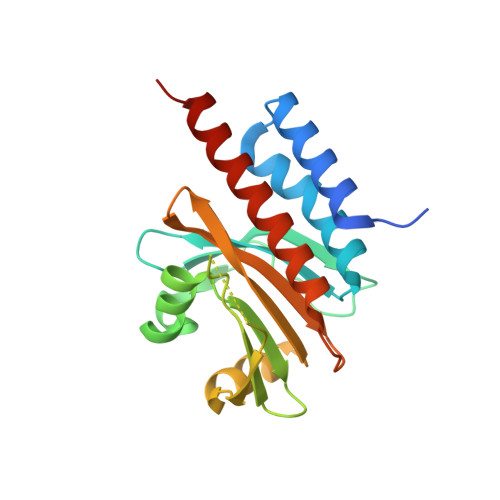The interplay between chromophore and protein determines the extended excited state dynamics in a single-domain phytochrome.
Slavov, C., Fischer, T., Barnoy, A., Shin, H., Rao, A.G., Wiebeler, C., Zeng, X., Sun, Y., Xu, Q., Gutt, A., Zhao, K.H., Gartner, W., Yang, X., Schapiro, I., Wachtveitl, J.(2020) Proc Natl Acad Sci U S A 117: 16356-16362
- PubMed: 32591422
- DOI: https://doi.org/10.1073/pnas.1921706117
- Primary Citation of Related Structures:
6OZA, 6OZB - PubMed Abstract:
Phytochromes are a diverse family of bilin-binding photoreceptors that regulate a wide range of physiological processes. Their photochemical properties make them attractive for applications in optogenetics and superresolution microscopy. Phytochromes undergo reversible photoconversion triggered by the Z ⇄ E photoisomerization about the double bond in the bilin chromophore. However, it is not fully understood at the molecular level how the protein framework facilitates the complex photoisomerization dynamics. We have studied a single-domain bilin-binding photoreceptor All2699g1 ( Nostoc sp. PCC 7120) that exhibits photoconversion between the red light-absorbing (P r ) and far red-absorbing (P fr ) states just like canonical phytochromes. We present the crystal structure and examine the photoisomerization mechanism of the P r form as well as the formation of the primary photoproduct Lumi-R using time-resolved spectroscopy and hybrid quantum mechanics/molecular mechanics simulations. We show that the unusually long excited state lifetime (broad lifetime distribution centered at ∼300 picoseconds) is due to the interactions between the isomerizing pyrrole ring D and an adjacent conserved Tyr142. The decay kinetics shows a strongly distributed character which is imposed by the nonexponential protein dynamics. Our findings offer a mechanistic insight into how the quantum efficiency of the bilin photoisomerization is tuned by the protein environment, thereby providing a structural framework for engineering bilin-based optical agents for imaging and optogenetics applications.
- Institute of Physical and Theoretical Chemistry, Goethe University, D-60438 Frankfurt, Germany; chslavov@theochem.uni-frankfurt.de xiaojing@uic.edu igor.schapiro@mail.huji.ac.il wveitl@theochem.uni-frankfurt.de.
Organizational Affiliation:

















